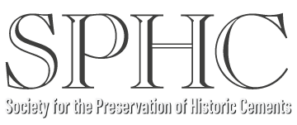THE 2ND AMERICAN NATURAL CEMENT CONFERENCE, 2006
March 30 – April 1, 2006
Washington, DC
Thousands of buildings and structures constucted with natural cement during the 19th and 20th Centuries remain in service, yet few restoration professionals are experienced in appropriately restoring and preserving these structures using original materials. This program is designed to provide the core knowledge needed to understand this traditional masonry and concrete technology:
- Where it has been used and its historical importance
- How it performs compared with other masonry materials
- How to correctly identify it in analyses of existing mortars, stuccos and concretes
- How to specify and execute appropriate, compatible, in-kind repair and replacement using authentic, historically accurate natural cement materials.
The Second American Natural Cement Conference will assemble international experts from a wide range of disciplines, including History, Chemistry, Engineering, Petrography, Restoration Architecture and the Masonry Trades. The first conference, held in the Rosendale, New York historic cement district in 2005, drew over 70 participants from 5 countries. Participants expressed their overwhelming approval for the conference’s rich technical and historical content. Just as importantly, they also had a lot of fun.
The conference is organized as a core 2-day program with an optional 3rd day extension. Choose to participate in a hands-on Natural Cement Training Workshop, or get a closer, more in-depth look at the geology and mines of the historic Potomac River Natural Cement district. Contractor certification will be offered for tradespeople participating in the Hands-On Workshop.
Program
DAY ONE: THURSDAY, MARCH 30, 2006
Perspectives
Leya Edison, VP, Edison Coatings, Inc., Moderator
Recap of the first American Natural Cement Conference (Rosendale, NY, 2005), and an introduction to the Second Conference program.
Video Slideshow:
“The Cement That Built America”
“A History of Natural Cement in Washington& the Potomac River Natural Cement Industry” Dr. Emory Kemp, Director, Institute of the History of Technology and Industrial Archaeology, West Virginia University Dr. Kemp draws from his extensive background and published works on the subject to retrace the history of natural cement production and use in the region, and its role in the building of some of our most revered historic structures.
“Petrography and the Proper Identification of Hydraulic Binders in Historic Mortars, Concretes and Stuccos” John Walsh, Testwell Laboratories, Ossining, NY Laura Powers, WJE Associates, Northbrook, IL Misidentification of historic hydraulic binders can lead to inappropriate material selection for restoration work. Mr. Walsh shares his experience in petrographic analysis of mortars, stuccos and concretes containing natural cement, hydraulic lime and early portland cement to illustrate techniques for proper identification of historic binders. Ms. Powers will discuss SEM and other advanced techniques for binder characterization.
“A Clearer Perspective on the Evolution of Early American Mortars” John Lambert, President, Abstract Masonry Restoration, Salt Lake City, UT and Boston, MA Ample attention has been paid to the history of portland cement and lime putty. This paper presents new research and information regarding the evolution of American unit masonry mortars during the 1800’s and early 1900’s and on the too-often overlooked history of natural cements, hydraulic limes, and dry lime hydrate binders.
Tour of Natural Cement Buildings, Bridges & Monuments In Washington, DC
Box Lunch bus tour will take participants to buildings, monuments, canals and bridges built with natural cement in Washington in the 19th Century. Tour culminates at the U. S. Capitol, site for the afternoon session.
“Masonry Repairs at Cheshire Mill #1, Historic Harrisville”
Linda Willett, Executive Director Frederick O’Connor, Project Manager The mortars selected and steps taken in preparation for major repairs of Cheshire Mill #1 are described, including lime mortars and Rosendale cement for selective repointing.
“Natural Cement Formulation, Performance & Standardization” Michael Edison, Chemical Engineer, Pres., Edison Coatings, Inc. This paper reviews formulation of 19th and early 20th century mortars, stuccos, concretes and grout. The evolution of natural cement performance standards is retraced, from the earliest US Army Corps of Engineers specifications to current efforts to reinstate ASTM C10 Standard Specification for Natural Cement.
Evening: Sponsored Dinner (Speaker TBA) “The Future of Public Funding for Historic Restoration”
DAY TWO: FRIDAY, MARCH 31, 2006
Harpers Ferry, Shepherdstown, and the C & O Canal
Depart by bus from the conference hotels in Washington,for a trip up the Potomac to the C & O Canal, Harpers Ferry and Potomac cement mines. En-route presentations on the C & O Canal, the Harpers Ferry National Historic Park and the region’s history by National Park Service interpreters. Christopher Robinson, Supervisory Exhibits Specialist, Historic Preservation Training Center Peter Dessauer, Historical Architect, Harpers Ferry National Historic Park Michael Siebert, C & O Canal National Historic Park
At Shepherdstown, visit the ruins of a natural cement plant and an abandoned quarry, and learn about the historical processing of natural cement.
“Natural Cement Geology & Mining” Dr. Kurtis Burmeister, Dept. of Geosciences, University of the Pacific
International Session: Roman Cement: Europe’s Pre-Portland Technology
“Calcination of marls to produce Roman Cement”
David Hughes, University of Bradford, W. Yorkshire, UK
“Hydration Processes in pastes of several Roman and natural cements” Renata Vyskocilova, Univ. of Pardubice, Czech Republic “Roman cement mortars in Europe’s architectural heritage of the 19th century”
Johannes Weber, University of Applied Arts, Vienna, Austria
At Harpers Ferry, take a special tour hosted by the National Park Service. Cross the Potomac by footbridge to visit a C & O Canal lock. Observe a live Natural Cement repointing demonstration on one of the park’s historic
structures, with Ken Uracius, Stone & Lime Imports, Inc.
DAY THREE OPTIONAL EXTENSION: SATURDAY, APRIL 1, 2006
1. In-depth geology tour: Potomac River cement mines
2. Hands-on Natural Cement training workshop, hosted by the National Park Service Historic Preservation Training Center in Frederick, MD.
